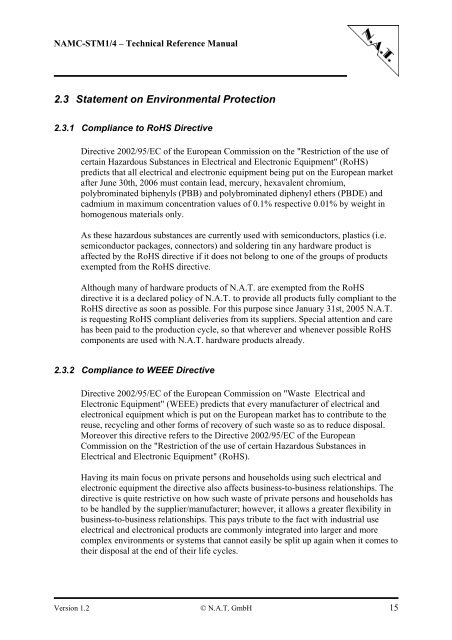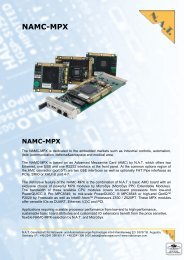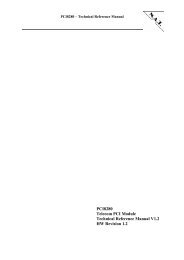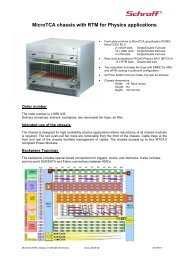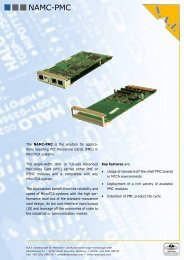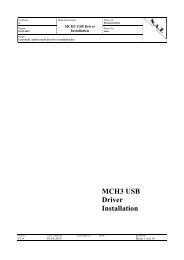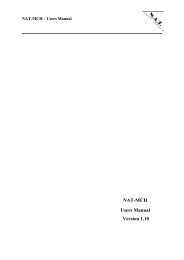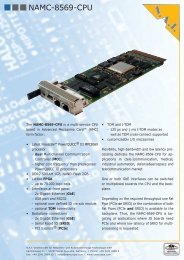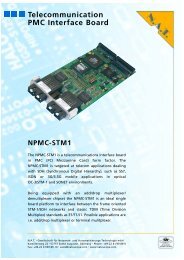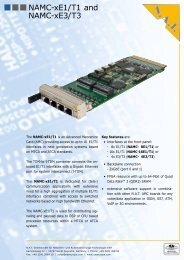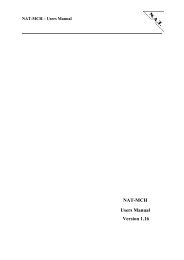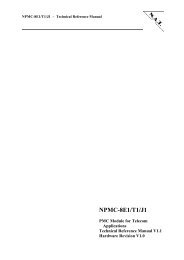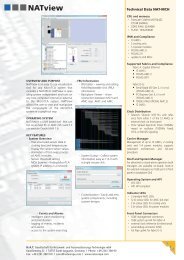NAMC-STM1/4 Telecom AMC Module Technical Reference ... - NAT
NAMC-STM1/4 Telecom AMC Module Technical Reference ... - NAT
NAMC-STM1/4 Telecom AMC Module Technical Reference ... - NAT
Create successful ePaper yourself
Turn your PDF publications into a flip-book with our unique Google optimized e-Paper software.
<strong>N<strong>AMC</strong></strong>-<strong>STM1</strong>/4 – <strong>Technical</strong> <strong>Reference</strong> Manual<br />
2.3 Statement on Environmental Protection<br />
2.3.1 Compliance to RoHS Directive<br />
Directive 2002/95/EC of the European Commission on the "Restriction of the use of<br />
certain Hazardous Substances in Electrical and Electronic Equipment" (RoHS)<br />
predicts that all electrical and electronic equipment being put on the European market<br />
after June 30th, 2006 must contain lead, mercury, hexavalent chromium,<br />
polybrominated biphenyls (PBB) and polybrominated diphenyl ethers (PBDE) and<br />
cadmium in maximum concentration values of 0.1% respective 0.01% by weight in<br />
homogenous materials only.<br />
As these hazardous substances are currently used with semiconductors, plastics (i.e.<br />
semiconductor packages, connectors) and soldering tin any hardware product is<br />
affected by the RoHS directive if it does not belong to one of the groups of products<br />
exempted from the RoHS directive.<br />
Although many of hardware products of N.A.T. are exempted from the RoHS<br />
directive it is a declared policy of N.A.T. to provide all products fully compliant to the<br />
RoHS directive as soon as possible. For this purpose since January 31st, 2005 N.A.T.<br />
is requesting RoHS compliant deliveries from its suppliers. Special attention and care<br />
has been paid to the production cycle, so that wherever and whenever possible RoHS<br />
components are used with N.A.T. hardware products already.<br />
2.3.2 Compliance to WEEE Directive<br />
Directive 2002/95/EC of the European Commission on "Waste Electrical and<br />
Electronic Equipment" (WEEE) predicts that every manufacturer of electrical and<br />
electronical equipment which is put on the European market has to contribute to the<br />
reuse, recycling and other forms of recovery of such waste so as to reduce disposal.<br />
Moreover this directive refers to the Directive 2002/95/EC of the European<br />
Commission on the "Restriction of the use of certain Hazardous Substances in<br />
Electrical and Electronic Equipment" (RoHS).<br />
Having its main focus on private persons and households using such electrical and<br />
electronic equipment the directive also affects business-to-business relationships. The<br />
directive is quite restrictive on how such waste of private persons and households has<br />
to be handled by the supplier/manufacturer; however, it allows a greater flexibility in<br />
business-to-business relationships. This pays tribute to the fact with industrial use<br />
electrical and electronical products are commonly integrated into larger and more<br />
complex environments or systems that cannot easily be split up again when it comes to<br />
their disposal at the end of their life cycles.<br />
Version 1.2 © N.A.T. GmbH 15


